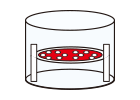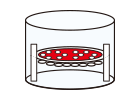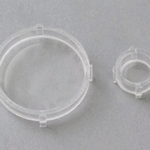Atelocollagen, Permeable Membrane for 6-well, 24-well Culture Plate
Features and Applications
 |
 |
 |
| Culture on membrane | Co-culture | Cell sheet transplantation |
- Since the collagen membrane is fully permeable to small molecules, cells cultured on this membrane will maintain their polarity and absorb nutrients/excrete metabolic waste products across the membrane.
- Because the membrane is transparent, microscopic observation of the cells is possible during culture.
- Two different cell types can be cultured, one on each side of the membrane, and this membrane is particularly useful for cell-cell interaction studies without direct cell-cell contact.
- It is biodegradable and suitable for cell sheet transplantation
Types of collagen
Bovine dermis derived atelocollagen
Specifications
| CM-6 | CM-24 | |
|---|---|---|
| Plate size | For 6-well plate | For 24-well plate |
| Volume | 2,860mm³ | 470mm³ |
| Culture area | 530mm² | 64mm² |
| Frame material | Polystyrene | Polystyrene |
Products
| Product name (click for order info) | Cat no (click for datasheet) | Size | |
| Atelocollagen Permeable Membrane (Well Format) | KOU-CM-24 | 6 Wells | |
| 24 Wells | |||
Frequently Asked Questions
How can I seed cells on Atelocollagen membrane?
Please visit our distributors’ page to download an instruction manual
Why do I have to neutralize Atelocollagen membrane before use?
The membrane is made from atelocollagen acidic solution and neutralization is necessary prior to cell culture.
How can I harvest cells from Atelocollagen membrane?
Use a cell scraper to harvest cells. We have confirmed that the membrane will not degrade upon treatment with lysis buffers contained in nucleic acid extraction kits.
Is it possible to prepare sections from Atelocollagen membrane?
Similar to tissue samples, Atelocollagen membrane can be fixed and/or embedded in paraffin/OCT compound.
How can I observe cells on Atelocollagen membrane?
Cells can be observed using a phase-contrast microscope. We recommend labelling cells beforehand so that you can easily identify cells seeded on each side of the membrane.
What are the differences between MEN-01 and CM-6/CM-24?
The same membrane is used for all three products but the shapes and sizes of the plastic frames holding the membrane are different. We also have Atelocollagen membrane without a plastic frame.
What are the differences between cell culture inserts and Atelocollagen membrane?
Usually a cell culture insert is made from synthetic resin while Atelocollagen membrane is made from 100% collagen. The membrane does not have definitive pores and cells cannot penetrate to the other side of the membrane, yet the membrane is permeable to small molecules. This is why cells can be harvested separately from each side of the membrane following co-culture. The membrane is biodegradable and suitable for cell transplantation.
Is it possible to obtain custom-made Atelocollagen membrane that is different in size and thickness from the off-the-shelf product?
Please contact us as we may be able to produce a custom-made product upon your request. You can also cut the membrane into smaller pieces with a sharp knife such as a surgical scalpel.
References
Co-culture
- Pigment Epithelium Derived Factor Is Involved in the Late Phase of Osteosarcoma Metastasis by Increasing Extravasation and Cell-Cell Adhesion.
Kuriyama S, Tanaka G, Takagane K, Itoh G, Tanaka M.
Front Oncol. 2022 Jan 31;12:818182. PMID: 35174090. - Mast cells promote viral entry of SARS-CoV-2 via formation of chymase/spike protein complex.
Liu S, Suzuki Y, Takemasa E, Watanabe R, Mogi M.
Eur J Pharmacol. 2022 Sep 5;930:175169. PMID: 35921955. - In vitro differentiation of theca cells from ovarian cells isolated from postmenopausal women.
Asiabi P, Dolmans MM, Ambroise J, Camboni A, Amorim CA.
Hum Reprod. 2020 Dec 1;35(12):2793-2807. PMID: 33326997. - Tubular bile duct structure mimicking bile duct morphogenesis for prospective in vitro liver metabolite recovery.
Rizki-Safitri A, Shinohara M, Tanaka M, Sakai Y.
J Biol Eng. 2020 Mar 19;14:11. PMID: 32206088 - Deciphering defective amelogenesis using in vitro culture systems.
Arinawati DY, Miyoshi K, Tanimura A, Horiguchi T, Hagita H, Noma T.
J Biosci Bioeng. 2018 Apr;125(4):479-489. PMID: 29397320 - Novel cardiac precursor-like cells from human menstrual blood-derived mesenchymal cells.
Hida N, Nishiyama N, Miyoshi S, Kira S, Segawa K, Uyama T, Mori T, Miyado K, Ikegami Y, Cui C, Kiyono T, Kyo S, Shimizu T, Okano T,
Sakamoto M, Ogawa S, Umezawa A.
Stem Cells. 2008 Jul;26(7):1695-1704. PMID: 18420831 - The significant cardiomyogenic potential of human umbilical cord blood-derived mesenchymal stem cells in vitro.
Nishiyama N, Miyoshi S, Hida N, Uyama T, Okamoto K, Ikegami Y, Miyado K, Segawa K, Terai M, Sakamoto M, Ogawa S, Umezawa A.
Stem Cells. 2007 Aug;25(8):2017-2024. PMID: 17495114 - Characterization of hair follicles induced in implanted, cultured rat keratinocyte sheets.
Miyashita H, Hakamata Y, Kobayashi E, Kobayashi K.
Exp Dermatol. 2004 Aug;13(8):491-8. PMID: 15265013 - Interaction between flavonoids and the blood-brain barrier: in vitro studies.
Youdim KA, Dobbie MS, Kuhnle G, Proteggente AR, Abbott NJ, Rice-Evans C.
J Neurochem. 2003 Apr;85(1):180-92. PMID: 12641740 - Lipids in blood-brain barrier models in vitro II: Influence of glial cells on lipid classes and lipid fatty acids.
Krämer SD, Schütz YB, Wunderli-Allenspach H, Abbott NJ, Begley DJ.
In Vitro Cell Dev Biol Anim. 2002 Nov-Dec;38(10):566-71. PMID: 12762838 - Modulation of tight junction structure in blood-brain barrier endothelial cells. Effects of tissue culture, second messengers and cocultured astrocytes.
Wolburg H, Neuhaus J, Kniesel U, Krauss B, Schmid EM, Ocalan M, Farrell C, Risau W.
J Cell Sci. 1994 May;107 (Pt 5):1347-57. PMID: 7929640 - Human corneal epithelial primary cultures and cell lines with extended life span: in vitro model for ocular studies.
Kahn CR, Young E, Lee IH, Rhim JS.
Invest Ophthalmol Vis Sci. 1993 Nov;34(12):3429-41. PMID: 7693609
Transplantation
- Corneal endothelial regeneration using mesenchymal stem cell derived from human umbilical cord.
Yamashita K, Inagaki E, Hatou S, Higa K, Ogawa A, Miyashita H, Tsubota K, Shimmura S.
Stem Cells Dev. 2018 Aug 15;27(16):1097-1108. PMID: 29929442 - Skin-Derived Precursors as a Source of Progenitors for Corneal Endothelial Regeneration.
Inagaki E, Hatou S, Higa K, Yoshida S, Shibata S, Okano H, Tsubota K, Shimmura S.
Stem Cells Transl Med. 2017 Mar;6(3):788-798. PMID: 28186681 - Basic Fibroblast Growth Factor-Anchored Multilayered Mesenchymal Cell Sheets Accelerate Periosteal Bone Formation.
Uchida K, Inoue G, Matsushita O, Horikawa K, Sekiguchi H, Saito W, Takano S, Fujimaki H, Miyagi M, Takaso M.
Biomed Res Int. 2017;2017:4371460. PMID: 28761877 - Optimization of Cultured Human Corneal Endothelial Cell Sheet Transplantation and Post-Operative Sheet Evaluation in a Rabbit Model.
Yamaguchi M, Shima N, Kimoto M, Ebihara N, Murakami A, Yamagami S.
Curr Eye Res. 2016 Sep;41(9):1178-84. PMID: 26828450 - Identification and Potential Application of Human Corneal Endothelial Progenitor Cells.
Hara S, Hayashi R, Soma T, Kageyama T, Duncan T, Tsujikawa M, Nishida K.
Stem Cells Dev. 2014 Sep 15;23(18):2190-201. PMID: 24588720 - Validation of Na,K-ATPase Pump Function of Corneal Endothelial Cells for Corneal Regenerative Medicine.
Hatou S, Higa K, Inagaki E, Yoshida S, Kimura E, Hayashi R, Tsujikawa M, Tsubota K, Nishida K, Shimmura S.
Tissue Eng Part C Methods. 2013 Dec;19(12):901-10. PMID: 23544359 - Functional Corneal Endothelium Derived from Corneal Stroma Stem Cells of Neural Crest Origin by Retinoic Acid and Wnt/β-Catenin Signaling.
Hatou S, Yoshida S, Higa K, Miyashita H, Inagaki E, Okano H, Tsubota K, Shimmura S.
Stem Cells Dev. 2013 Mar 1;22(5):828-39. PMID: 22974347 - Omentopexy enhances graft function in myocardial cell sheet transplantation.
Suzuki R, Hattori F, Itabashi Y, Yoshioka M, Yuasa S, Manabe-Kawaguchi H, Murata M, Makino S, Kokaji K, Yozu R, Fukuda K.
Biochem Biophys Res Commun. 2009 Sep 18;387(2):353-359. PMID: 19595673 - Direct induction of layered tissues from mouse embryonic stem cells: potential for differentiation into urinary tract tissue.
Kinebuchi Y, Johkura K, Sasaki K, Imamura T, Mimura Y, Nishizawa O.
Cell Tissue Res. 2008 Mar;331(3):605-615. PMID: 18087725 - Identification of a potent combination of osteogenic genes for bone regeneration using embryonic stem (ES) cell-based sensor.
Ohba S, Ikeda T, Kugimiya F, Yano F, Lichtler AC, Nakamura K, Takato T, Kawaguchi H, Chung UI.
FASEB J. 2007 Jun;21(8):1777-87. PMID: 17317722 - Pulsatile cardiac tissue grafts using a novel three-dimensional cell sheet manipulation technique functionally integrates with the host heart, in vivo.
Furuta A, Miyoshi S, Itabashi Y, Shimizu T, Kira S, Hayakawa K, Nishiyama N, Tanimoto K, Hagiwara Y, Satoh T, Fukuda K, Okano T, Ogawa S.
Circ Res. 2006 Mar 17;98(5):705-12. PMID: 16469955 - Fabrication of pulsatile cardiac tissue grafts using a novel 3-dimensional cell sheet manipulation technique and temperature-responsive cell culture surfaces.
Shimizu T, Yamato M, Isoi Y, Akutsu T, Setomaru T, Abe K, Kikuchi A, Umezu M, Okano T.
Circ Res. 2002 Feb 22;90(3):e40. PMID: 11861428
Culture on membrane, Miscellaneous
- Treated dentin matrix induces odontogenic differentiation of dental pulp stem cells via regulation of Wnt/β-catenin signaling.
Liu S, Sun J, Yuan S, Yang Y, Gong Y, Wang Y, Guo R, Zhang X, Liu Y, Mi H, Wang M, Liu M, Li R.
Bioact Mater. 2021 Jun 5;7:85-97. PMID: 34466719 - Scaffold-free tissue-engineered arterial grafts derived from human skeletal myoblasts.
Saito J, Yokoyama U, Nakamura T, Kanaya T, Ueno T, Naito Y, Takayama T, Kaneko M, Miyagawa S, Sawa Y, Ishikawa Y.
Artif Organs. 2021 Aug;45(8):919-932. PMID: 33539557. - Enzyme-digested Colla Corii Asini (E'jiao) accelerates wound healing and prevents ultraviolet A-induced collagen synthesis decline and wrinkle formation in three-dimensional skin equivalents.
Xiao L, Liao F, Fan Y, Miwa N.
Hum Cell. 2020 Oct;33(4):1056-1067. Erratum in: Hum Cell. 2021 Jan;34(1):291. PMID: 32761322. - Reconstitution of the embryonic kidney identifies a donor cell contribution to the renal vasculature upon transplantation.
Murakami Y, Naganuma H, Tanigawa S, Fujimori T, Eto M, Nishinakamura R.
Sci Rep. 2019 Feb 4;9(1):1172. PMID: 30718617 - "All-in-one" in vitro selection of collagen-binding vascular endothelial growth factor.
Park SH, Uzawa T, Hattori F, Ogino S, Morimoto N, Tsuneda S, Ito Y.
Biomaterials. 2018 Apr;161:270-278. PMID: 29425847 - Spontaneous acquisition of infinite proliferative capacity by a rabbit corneal endothelial cell line with maintenance of phenotypic and physiological characteristics.
Kageyama T, Hayashi R, Hara S, Yoshikawa K, Ishikawa Y, Yamato M, Nishida K.
J Tissue Eng Regen Med. 2017 Apr;11(4):1057-1064. PMID: 25758102 - Fluorous solvent effect on cells cultured on collagen membrane at the interface.
MC Kasuya, K Isozaki, K Miyamura, K Hatanaka.
Journal of Fluorine Chemistry Volume 178, October 2015, Pages 183–186. - Role of hepatocyte growth factor in promoting the growth of human corneal endothelial cells stimulated by L-ascorbic Acid 2-phosphate.
Kimoto M, Shima N, Yamaguchi M, Amano S, Yamagami S.
Invest Ophthalmol Vis Sci. 2012 Nov 9;53(12):7583-9. PMID: 23081981 - Increased proliferation and replicative lifespan of isolated human corneal endothelial cells with L-ascorbic acid 2-phosphate.
Shima N, Kimoto M, Yamaguchi M, Yamagami S.
Invest Ophthalmol Vis Sci. 2011 Nov 7;52(12):8711-7. PMID: 21980003 - Electrically induced contraction of C2C12 myotubes cultured on a porous membrane-based substrate with muscle tissue-like stiffness.
Kaji H, Ishibashi T, Nagamine K, Kanzaki M, Nishizawa M.
Biomaterials. 2010 Sep;31(27):6981-6986. PMID: 20561677 - Effects of multipurpose contact-lens care solutions on adhesion of Pseudomonas aeruginosa to corneal epithelial cells.
Imayasu M, Shimizu H, Shimada S, Suzuki T, Cavanagh HD.
Eye Contact Lens. 2009 Mar;35(2):98-104. PMID: 19265332 - Effect of lactoferrin-embedded collagen membrane on osteogenic differentiation of human osteoblast-like cells.
Takayama Y, Mizumachi K.
J Biosci Bioeng. 2009 Feb;107(2):191-5. PMID: 19217559 - Immunogold electron microscopic demonstration of distinct submembranous localization of the activated gammaPKC depending on the stimulation.
Oyasu M, Fujimiya M, Kashiwagi K, Ohmori S, Imaeda H, Saito N.
J Histochem Cytochem. 2008 Mar;56(3):253-265. PMID: 18040079 - Effects of multipurpose solutions on corneal epithelial tight junctions.
Imayasu M, Shiraishi A, Ohashi Y, Shimada S, Cavanagh HD.
Eye Contact Lens. 2008 Jan;34(1):50-55. PMID: 18180685 - Polycomb group gene silencing proteins are concentrated in the perichromatin compartment of the mammalian nucleus.
Cmarko D, Verschure PJ, Otte AP, van Driel R, Fakan S.
J Cell Sci. 2003 Jan 15;116(Pt 2):335-43. PMID: 12482919 - In-vitro nasal drug delivery studies: comparison of derivatised, fibrillar and polymerised collagen matrix-based human nasal primary culture systems for nasal drug delivery studies.
Agu RU, Jorissen M, Willems T, Augustijns P, Kinget R, Verbeke N.
J Pharm Pharmacol. 2001 Nov;53(11):1447-56. PMID: 11732747 - Heparin-carrying polystyrene (HCPS)-bound collagen substratum to immobilize heparin-binding growth factors and to enhance cellular growth.
Ishihara M, Sato M, Hattori H, Saito Y, Yura H, Ono K, Masuoka K, Kikuchi M, Fujikawa K, Kurita A.
J Biomed Mater Res. 2001 Sep 15;56(4):536-44. PMID: 11400131 - Minor role of Cl- secretion in non-cystic fibrosis and cystic fibrosis human nasal epithelium.
Rückes-Nilges C, Weber U, Lindemann H, Münker G, Clauss W, Weber WM.
Cell Physiol Biochem. 1999;9(1):1-10. PMID: 10352340 - Measurement of paracellular epithelial conductivity by conductance scanning.
Gitter AH, Bertog M, Schulzke J, Fromm M.
Pflugers Arch. 1997 Nov;434(6):830-40. PMID: 9306019 - Polarized epithelial cells of the hamster seminal vesicle in a serum-free bicameral culture system: evidence of secretory and endocytic activities.
Rodrigues G, Gulbenkian S, Mata LR.
Cell Tissue Res. 1995 Oct;282(1):181-92. PMID: 8581921 - Carrier-mediated transport of H1-antagonist at the blood-brain barrier: mepyramine uptake into bovine brain capillary endothelial cells in primary monolayer cultures.
Yamazaki M, Terasaki T, Yoshioka K, Nagata O, Kato H, Ito Y, Tsuji A.
Pharm Res. 1994 Jul;11(7):975-8. PMID: 7937557 - Whole-cell currents in single and confluent M-1 mouse cortical collecting duct cells.
Korbmacher C, Segal AS, Fejes-Tóth G, Giebisch G, Boulpaep EL.
J Gen Physiol. 1993 Oct;102(4):761-93. PMID: 8270912 - Development and characterisation of a rat brain capillary endothelial culture: towards an in vitro blood-brain barrier.
Abbott NJ, Hughes CC, Revest PA, Greenwood J.
J Cell Sci. 1992 Sep;103 ( Pt 1):23-37. PMID: 1429907


